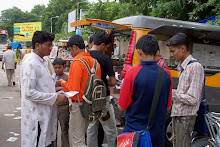Indian Express: New Delhi: Wednesday, May 17, 2017.
RTI
records show that the requests to stop the construction of towers were sent
last year by Daddan Mishra, a BJP Lok Sabha MP from Shravasti in UP, and
Sakuntala Laguri, a BJD Lok Sabha MP from Keonjhar in Odisha.
THE TELECOM
Ministry has rejected requests from two MPs, including one from the BJP, to
stop the construction of mobile towers in specific areas of their
constituencies due to public health concerns over electromagnetic radiation,
according to records obtained by The Indian Express under the Right to
Information (RTI) Act.
RTI records
show that Manoj Sinha, Minister of State (independent charge), Department of
Telecommunications (DoT), denied the requests stating that the tower “has not
yet been operational” in one case and that the amount of electromagnetic
radiation emitted has been “found to be compliant as per the DoT norms” in the
other.
RTI records
show that the requests to stop the construction of towers were sent last year
by Daddan Mishra, a BJP Lok Sabha MP from Shravasti in UP, and Sakuntala
Laguri, a BJD Lok Sabha MP from Keonjhar in Odisha.
According to
the RTI records, Mishra wrote to the then telecom minister Ravishankar Prasad
on April 17, 2016, stating that Indus Towers India’s largest telecom towers
company and a joint venture of Airtel, Vodafone and Idea was establishing a
mobile tower near a “populated area” and a “school” in Motinagar village
without a “no-objection certificate (NOC)”.
“As per the
report of the World Health Organisation (WHO), electromagnetic radiations
emitted by mobile towers invite serious diseases,” wrote Mishra. The MP asked
Prasad to take “strict action against Indus Towers” and give directions to
“concerned officers” to “remove the telecom towers from populated area and
school area”.
Mishra also
claimed that the towers were being established without NOCs. To back his claim,
the MP attached a letter written by the Nand Kumar Pandey, the then pradhan of
Motinagar gram panchayat. In the letter addressed to the district collector,
Pandey wrote: “I think the company must have submitted the NOC with the fake
signature to the department concerned. However, the village administration,
school administration as well as students have been opposing the establishment
of this mobile tower.”
On July 6,
2016, Sinha replaced Prasad as Telecom Minister. And, On August 17, 2016, he
replied to Mishra: “In the instant case, the Telecom Enforcement, Resource and
Monitoring (TERM) cell of UP(E) circle was directed to get the radiation level
measured for the mobile towers in question and to submit a detailed report on
the representation. The report from TERM cell of UP(E) circle states that the
tower under reference has not yet been operational. Also, a NOC for the mobile
tower in question was obtained from the concerned gram pradhan Nand Kumar
Pandey (complainant himself). I hope you may agree with the position in the
matter.”
Indus Towers
did not respond to requests seeking comment by The Indian Express.
On September
30, 2016, BJD MP Laguri, in a letter to Sinha, wrote that telecom operators
have either established or are going to erect telecom towers in “school,
college, hospital and residential vicinity areas of my constituency, including
two such towers in district headquarter hospital area of Keonjhar”. In his
reply, dated January 25 this year, Sinha wrote: “In the instant case… the
report from TERM (Telecom Enforcement, Resource and Monitoring) cell of Odisha
circle states that the radiation level at these locations have been measured
and found to be compliant as per DoT norms.”
On the impact
on health of electromagnetic field emissions from mobile towers, Sinha wrote to
Mishra and Laguri that the World Health Organization had had concluded, based
on “an in-depth review of scientific literature”, that the “current evidence
does not confirm the existence of any health consequences from exposure to low
level electromagnetic fields”.
Sinha told
the MPs that the DoT has laid down precautionary norms, which are ten times
more stringent than the existing limits prescribed by International Commission
on Non-ionizing Radiation Protection (ICNIRP), for exposure limit for a radio
frequency field.






























